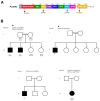Loss-of-function variants in SEMA3F and PLXNA3 encoding semaphorin-3F and its receptor plexin-A3 respectively cause idiopathic hypogonadotropic hypogonadism
- PMID: 33495532
- PMCID: PMC7612467
- DOI: 10.1038/s41436-020-01087-5
Loss-of-function variants in SEMA3F and PLXNA3 encoding semaphorin-3F and its receptor plexin-A3 respectively cause idiopathic hypogonadotropic hypogonadism
Abstract
Purpose: Idiopathic hypogonadotropic hypogonadism (IHH) is characterized by absent puberty and subsequent infertility due to gonadotropin-releasing hormone (GnRH) deficiency. IHH can be accompanied by normal or compromised olfaction (Kallmann syndrome). Several semaphorins are known potent modulators of GnRH, olfactory, and vomeronasal system development. In this study, we investigated the role of Semaphorin-3F signaling in the etiology of IHH.
Methods: We screened 216 IHH patients by exome sequencing. We transiently transfected HEK293T cells with plasmids encoding wild type (WT) or corresponding variants to investigate the functional consequences. We performed fluorescent IHC to assess SEMA3F and PLXNA3 expression both in the nasal region and at the nasal/forebrain junction during the early human fetal development.
Results: We identified ten rare missense variants in SEMA3F and PLXNA3 in 15 patients from 11 independent families. Most of these variants were predicted to be deleterious by functional assays. SEMA3F and PLXNA3 are both expressed along the olfactory nerve and intracranial projection of the vomeronasal nerve/terminal nerve. PLXNA1-A3 are expressed in the early migratory GnRH neurons.
Conclusion: SEMA3F signaling through PLXNA1-A3 is involved in the guidance of GnRH neurons and of olfactory and vomeronasal nerve fibers in humans. Overall, our findings suggest that Semaphorin-3F signaling insufficiency contributes to the pathogenesis of IHH.
Conflict of interest statement
Figures




Similar articles
-
PLXNB1 mutations in the etiology of idiopathic hypogonadotropic hypogonadism.J Neuroendocrinol. 2022 Apr;34(4):e13103. doi: 10.1111/jne.13103. Epub 2022 Feb 16. J Neuroendocrinol. 2022. PMID: 35170806 Free PMC article.
-
PLXNA1 and PLXNA3 cooperate to pattern the nasal axons that guide gonadotropin-releasing hormone neurons.Development. 2019 Nov 5;146(21):dev176461. doi: 10.1242/dev.176461. Development. 2019. PMID: 31690636
-
Analysis of PLXNA1, NRP1, and NRP2 variants in a cohort of patients with isolated hypogonadotropic hypogonadism.Mol Genet Genomic Med. 2021 Nov;9(11):e1816. doi: 10.1002/mgg3.1816. Epub 2021 Oct 11. Mol Genet Genomic Med. 2021. PMID: 34636164 Free PMC article.
-
Kallmann syndrome and idiopathic hypogonadotropic hypogonadism: The role of semaphorin signaling on GnRH neurons.Handb Clin Neurol. 2021;182:307-315. doi: 10.1016/B978-0-12-819973-2.00022-8. Handb Clin Neurol. 2021. PMID: 34266601 Free PMC article. Review.
-
Molecular genetics of isolated hypogonadotropic hypogonadism and Kallmann syndrome.Endocr Dev. 2005;8:67-80. doi: 10.1159/000084094. Endocr Dev. 2005. PMID: 15722618 Review.
Cited by
-
Mini-Puberty, Physiological and Disordered: Consequences, and Potential for Therapeutic Replacement.Endocr Rev. 2024 Jul 12;45(4):460-492. doi: 10.1210/endrev/bnae003. Endocr Rev. 2024. PMID: 38436980 Free PMC article. Review.
-
Systematic analysis and prediction of genes associated with monogenic disorders on human chromosome X.Nat Commun. 2022 Nov 2;13(1):6570. doi: 10.1038/s41467-022-34264-y. Nat Commun. 2022. PMID: 36323681 Free PMC article.
-
The p190 RhoGAPs, ARHGAP35, and ARHGAP5 are implicated in GnRH neuronal development: Evidence from patients with idiopathic hypogonadotropic hypogonadism, zebrafish, and in vitro GAP activity assay.Genet Med. 2022 Dec;24(12):2501-2515. doi: 10.1016/j.gim.2022.08.025. Epub 2022 Sep 30. Genet Med. 2022. PMID: 36178483 Free PMC article.
-
SEMA6A drives GnRH neuron-dependent puberty onset by tuning median eminence vascular permeability.Nat Commun. 2023 Dec 7;14(1):8097. doi: 10.1038/s41467-023-43820-z. Nat Commun. 2023. PMID: 38062045 Free PMC article.
-
PLXNB1 mutations in the etiology of idiopathic hypogonadotropic hypogonadism.J Neuroendocrinol. 2022 Apr;34(4):e13103. doi: 10.1111/jne.13103. Epub 2022 Feb 16. J Neuroendocrinol. 2022. PMID: 35170806 Free PMC article.
References
-
- Casoni F, et al. Development of the neurons controlling fertility in humans: new insights from 3D imaging and transparent fetal brains. Development. 2016;143:3969–3981. - PubMed
-
- Schwanzel-Fukuda M, et al. Migration of luteinizing hormone-releasing hormone (LHRH) neurons in early human embryos. J Comp Neurol. 1996;366:547–57. - PubMed
-
- Pasterkamp RJ. Getting neural circuits into shape with semaphorins. Nat Rev Neurosci. 2012;13:605–18. - PubMed
Publication types
MeSH terms
Substances
Supplementary concepts
Grants and funding
LinkOut - more resources
Full Text Sources
Other Literature Sources

